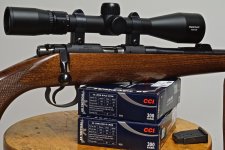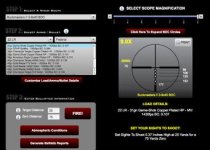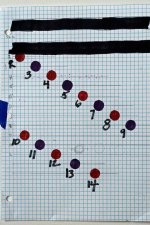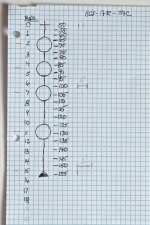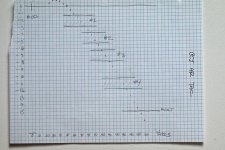5-Shot
Member
I love a good puzzle. Always have. This one was about as good as it gets.
After several years spending way too much on the Rimfirecentral forum I finally found myself on the loose in Buds Lexington store with a little extra balance in the checking account. To my delight they had a nice CZ 452 Trainer on display and were more than willing to part with it. One of the CZ's many appeals to me was a graduated rear sight similar to those found on old military Mausers. Once sighted in at a specific range one could, theoretically, move to another distance a scoot the sight slider to that range and be dead on. Naturally, I bought it.
The first thing I did on arriving home was to perform the simple trigger adjustments described on the above mentioned forum (which worked perfectly) and then head to the back yard. I sighted my new rifle in at 50 yards and was rewarded with nice round 3/4 inch groups, perfectly located (iron sights). Then it was time to back up and try that nifty rear sight at longer ranges. Unanticipated problem! For years I have battled advancing age with carefully chosen Walmart reading glasses and a Merit eye disc. The reading glasses were selected to bring the front sight into focus and the disc cleared up the distant target. It was a rude shock to discover that I could no longer pull it off. Glasses strong enough to snap the front sight into view were too strong to be offset by the disc. Scope time!
I gave up hunting several years ago (see advancing age, above) so I have a good supply of quality high-power rifle scopes, mounts and rings lying around the house. Finding workable combination for the CZ wasn't too hard. That allowed me to move on to ammo testing. As you know, 22's can be pretty picky. For example, this rifle just loves Eley Target (who doesn't) but can't tolerate Federal Auto Match. Surprisingly, it thanks CCI AR Tactical is pretty dandy stuff, and you'll no doubt agree it is economically superior to Eley. CCI's what I used in the shooting described below.
During all this testing one nagging point kept rattling around in the back of my mind. "This fine Leupold scope is parallax adjusted for 100 yards and I'm shooting at 50. That can't be right." I really needed a 22 scope or something with an adjustable objective. As luck would have it I attended the grand opening of one of those big box sporting goods stores in my community and they had a killer deal on Nikon 3x9 Prostaff Rimfire BDC scopes. I couldn't let that slip by. I bought it and it worked great. The combination is shown in the first picture.
There's an added bonus feature in this scope call the BDC…bullet drop compensator. Sort of an optical version of my sliding rear sight. Look to the right side of the second picture (sorry about the size, it was a screen shot) and you'll get an idea of what it looks like in the scope, absent all the numbers of course. Here's how it works: go to Nikon's Spoton web site and open the page you see in the second picture, choose your scope, choose your ammo and choose your sight in distance. That allows you to generate all sorts of interesting tables and graphs or you can go to the picture on the right and see at what ranges those circles will put you dead on.
There's only one problem. IT DOESN'T WORK! Thinking that, as usual, the problem was yours truly, I checked around the WWW. Their conclusions seem to match mine. Fine scope, especially for the money but the BCD is simply wrong.
My first hunch was that their ballistic model was in error. Fortunately, the Generate Ballistics Reports button allows you to print up some pretty detailed trajectory tables. To see if they were the problem, I went to JBM Ballistics' fine site and used the same muzzle velocity and ballistics coefficients that Nikon had employed. Surprise! Nikon and JBM figures were nearly perfect matches. Keep looking!
Next on the agenda was to determine where, exactly, those circles in my scope were located. That's where the third photo comes in. Assuming the center of that gap between the two dark lines is "zero", those colorful dots are the designated minutes of angle below "zero". I performed my examination at 50 yards so dot 4, for example, is four minutes, or two inches below the "zero" gap. I hung that sheet up fifty yards, placed the horizontal crosshair in the gap and looked for where the circles were. The first circle was down two minutes of angle, the second circle was at -4.5 minutes, circle 3 at - 7.0 minutes, circle 4 at -11.0 minutes and the post is down 15.0 minutes. In addition, the circles are three minutes of angle in diameter. All very useful information.
Armed with the knowledge of the circle locations it was possible to run the JBM ballistic program again and determine at what range each of the circles should be dead on. I chose to begin my testing with circle three. That circle is down 7 minutes of angle and according to JBM the CCI bullet should drop that far below the 50 yard zero at around 107 yards. Disappointingly, shooting showed it was a little lower. After some intense head scratching I plugged in several different muzzle velocity values into JBM and found that 1150 feet/second worked far better than the published 1200 I had been using. Assuming 1150 ft/sec had the bullet landing exactly where it should land.
After some reflection that made perfect sense. Twenty two rifles produce their maximum velocity with barrels around 16 or 17 inches long. I presume CCI publishes the best (fastest) velocities they can. Longer barrels are slower. My CZ barrel is a bit over 24 inches long.
With all the pieces of the puzzle finally falling into place I was able to produce the the range charts depicted in photos 4 and 5. Using those I should be able to aim with confidence at anything out to about 150 yards. To see if it worked, I conducted the following test. I carried my portable bullet stop in the yard out to a convenient spot and set it down (I live out in the sticks), walked back to my bench, lasered the range, consulted my range chart and fired three rounds. I did this four different times at what turned out to be at randomly selected 113, 99, 84 and 67 yards. The results are shown in the final photo. I'm not too proud of my shooting but the target in the last picture confirms to my satisfaction that the system actually and finally works. For reference the red circle is 1.7 inches in diameter.
Due to photo limits the last photo is in a response below.
Ed
After several years spending way too much on the Rimfirecentral forum I finally found myself on the loose in Buds Lexington store with a little extra balance in the checking account. To my delight they had a nice CZ 452 Trainer on display and were more than willing to part with it. One of the CZ's many appeals to me was a graduated rear sight similar to those found on old military Mausers. Once sighted in at a specific range one could, theoretically, move to another distance a scoot the sight slider to that range and be dead on. Naturally, I bought it.
The first thing I did on arriving home was to perform the simple trigger adjustments described on the above mentioned forum (which worked perfectly) and then head to the back yard. I sighted my new rifle in at 50 yards and was rewarded with nice round 3/4 inch groups, perfectly located (iron sights). Then it was time to back up and try that nifty rear sight at longer ranges. Unanticipated problem! For years I have battled advancing age with carefully chosen Walmart reading glasses and a Merit eye disc. The reading glasses were selected to bring the front sight into focus and the disc cleared up the distant target. It was a rude shock to discover that I could no longer pull it off. Glasses strong enough to snap the front sight into view were too strong to be offset by the disc. Scope time!
I gave up hunting several years ago (see advancing age, above) so I have a good supply of quality high-power rifle scopes, mounts and rings lying around the house. Finding workable combination for the CZ wasn't too hard. That allowed me to move on to ammo testing. As you know, 22's can be pretty picky. For example, this rifle just loves Eley Target (who doesn't) but can't tolerate Federal Auto Match. Surprisingly, it thanks CCI AR Tactical is pretty dandy stuff, and you'll no doubt agree it is economically superior to Eley. CCI's what I used in the shooting described below.
During all this testing one nagging point kept rattling around in the back of my mind. "This fine Leupold scope is parallax adjusted for 100 yards and I'm shooting at 50. That can't be right." I really needed a 22 scope or something with an adjustable objective. As luck would have it I attended the grand opening of one of those big box sporting goods stores in my community and they had a killer deal on Nikon 3x9 Prostaff Rimfire BDC scopes. I couldn't let that slip by. I bought it and it worked great. The combination is shown in the first picture.
There's an added bonus feature in this scope call the BDC…bullet drop compensator. Sort of an optical version of my sliding rear sight. Look to the right side of the second picture (sorry about the size, it was a screen shot) and you'll get an idea of what it looks like in the scope, absent all the numbers of course. Here's how it works: go to Nikon's Spoton web site and open the page you see in the second picture, choose your scope, choose your ammo and choose your sight in distance. That allows you to generate all sorts of interesting tables and graphs or you can go to the picture on the right and see at what ranges those circles will put you dead on.
There's only one problem. IT DOESN'T WORK! Thinking that, as usual, the problem was yours truly, I checked around the WWW. Their conclusions seem to match mine. Fine scope, especially for the money but the BCD is simply wrong.
My first hunch was that their ballistic model was in error. Fortunately, the Generate Ballistics Reports button allows you to print up some pretty detailed trajectory tables. To see if they were the problem, I went to JBM Ballistics' fine site and used the same muzzle velocity and ballistics coefficients that Nikon had employed. Surprise! Nikon and JBM figures were nearly perfect matches. Keep looking!
Next on the agenda was to determine where, exactly, those circles in my scope were located. That's where the third photo comes in. Assuming the center of that gap between the two dark lines is "zero", those colorful dots are the designated minutes of angle below "zero". I performed my examination at 50 yards so dot 4, for example, is four minutes, or two inches below the "zero" gap. I hung that sheet up fifty yards, placed the horizontal crosshair in the gap and looked for where the circles were. The first circle was down two minutes of angle, the second circle was at -4.5 minutes, circle 3 at - 7.0 minutes, circle 4 at -11.0 minutes and the post is down 15.0 minutes. In addition, the circles are three minutes of angle in diameter. All very useful information.
Armed with the knowledge of the circle locations it was possible to run the JBM ballistic program again and determine at what range each of the circles should be dead on. I chose to begin my testing with circle three. That circle is down 7 minutes of angle and according to JBM the CCI bullet should drop that far below the 50 yard zero at around 107 yards. Disappointingly, shooting showed it was a little lower. After some intense head scratching I plugged in several different muzzle velocity values into JBM and found that 1150 feet/second worked far better than the published 1200 I had been using. Assuming 1150 ft/sec had the bullet landing exactly where it should land.
After some reflection that made perfect sense. Twenty two rifles produce their maximum velocity with barrels around 16 or 17 inches long. I presume CCI publishes the best (fastest) velocities they can. Longer barrels are slower. My CZ barrel is a bit over 24 inches long.
With all the pieces of the puzzle finally falling into place I was able to produce the the range charts depicted in photos 4 and 5. Using those I should be able to aim with confidence at anything out to about 150 yards. To see if it worked, I conducted the following test. I carried my portable bullet stop in the yard out to a convenient spot and set it down (I live out in the sticks), walked back to my bench, lasered the range, consulted my range chart and fired three rounds. I did this four different times at what turned out to be at randomly selected 113, 99, 84 and 67 yards. The results are shown in the final photo. I'm not too proud of my shooting but the target in the last picture confirms to my satisfaction that the system actually and finally works. For reference the red circle is 1.7 inches in diameter.
Due to photo limits the last photo is in a response below.
Ed

